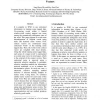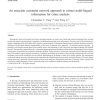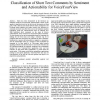35 search results - page 7 / 7 » A Method for Determining Ontology-Based Semantic Relevance |
LREC
2008
13 years 6 months ago
2008
Acquiring knowledge from the Web to build domain ontologies has become a common practice in the Ontological Engineering field. The vast amount of freely available information allo...
TCSV
2011
13 years 10 days ago
2011
—As it is true for human perception that we gather information from different sources in natural and multi-modality forms, learning from multi-modalities has become an effective ...
COLING
2002
13 years 5 months ago
2002
It is popular in WSD to use contextual information in training sense tagged data. Co-occurring words within a limited window-sized context support one sense among the semantically...
DSS
2007
13 years 5 months ago
2007
International crime and terrorism have drawn increasing attention in recent years. Retrieving relevant information from criminal records and suspect communications is important in...
SOCIALCOM
2010
13 years 4 days ago
2010
Much has been documented in the literature on sentiment analysis and document summarisation. Much of this applies to long structured text in the form of documents and blog posts. W...



